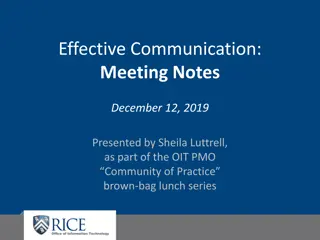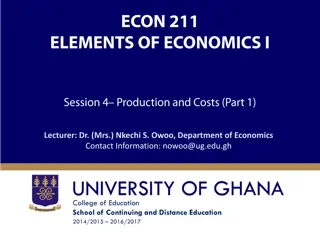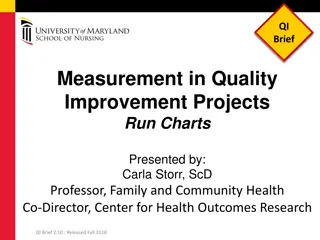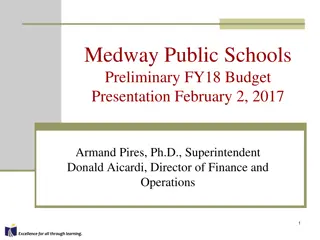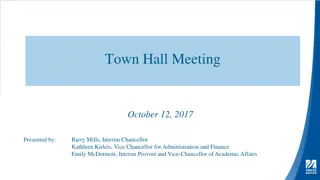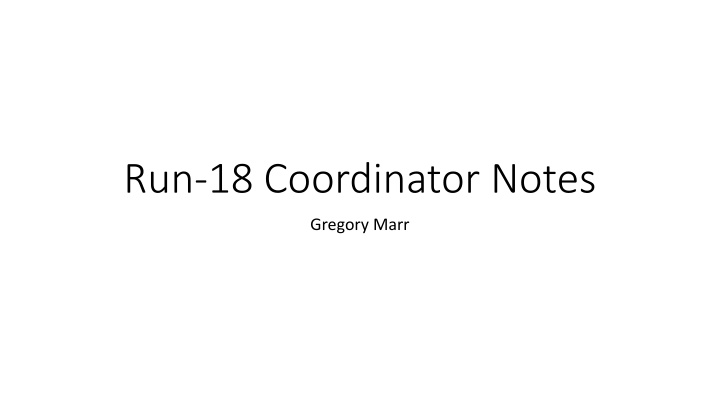
RHIC Run 18 Coordinator Notes Overview
Explore the detailed insights from the RHIC Run 18 Coordinator Notes by Gregory Marr regarding the exceptional performance, failures, and operational highlights of the run. Gain valuable information on Mean Time Between Failure, Mean Time To Repair, system failures, and comparisons with past runs.
Download Presentation

Please find below an Image/Link to download the presentation.
The content on the website is provided AS IS for your information and personal use only. It may not be sold, licensed, or shared on other websites without obtaining consent from the author. If you encounter any issues during the download, it is possible that the publisher has removed the file from their server.
You are allowed to download the files provided on this website for personal or commercial use, subject to the condition that they are used lawfully. All files are the property of their respective owners.
The content on the website is provided AS IS for your information and personal use only. It may not be sold, licensed, or shared on other websites without obtaining consent from the author.
E N D
Presentation Transcript
Run-18 Coordinator Notes Gregory Marr
The run It s hard to complain when the overall performance of the run was so spectacular. MTBF and MTTR were unprecedented. However, medium ions@high energy, heavy ions@medium energy, long stores, stochastic cooling, 1 collision point, low intensity requirements, etc. give a false sense of complacency. It won t be that easy again. We are doing better at start up than ever before. Even with snowstorms in the way. We made long strides this year with mode switching in the collider. Low energy vs. nominal injection does not have this full capability. Yet.
RHIC Availability by Run[%] Courtesy P. Ingrassia 95% 90% 85% 80% 75% 70% 65% 60% Run2 Run3 Run4 Run5 Run6 Run7 Run8 Run9 Run10 Run11 Run12 Run13 Run14 Run15 Run16 Run17 Run18
Mean Time Between Failure, Mean Time To Repair, Average Failure hours/day [cryo start to cryo end date] Courtesy P. Ingrassia 10 MTBF (h) MTTR (h) <Failure h/da> 9.3 8 8.6 Hours (h) 8.1 6.8 6 6.9 6.6 6.3 6.3 6.4 5.7 5.5 5.3 5.5 4 4.5 3.8 3.7 3.5 3.8 3.0 4.42 3.6 3.0 3.1 2 2.1 2.0 1.2 1.2 1.3 1.2 1.3 1.1 1.2 1.1 1.2 0.9 0 1.0 Run7 Run8 Run9 Run10 Run11 Run12 Run13 Run14 Run15 Run16 Run17 Run18
RHIC Run18 TOP 10 Failures by Group/System 1.5% Courtesy P. Ingrassia Lots of access %Scheduled Operations 4th place if you add AGS Higher than previous runs 1.0% 0.5% 0.0% PS_RHIC ES&FD_Exp QuenchDetect HumanError PPS_RHIC EBIS RfRHIC CryoRHIC ElecRHIC Weather System/Group
Compare to another high-availability run Courtesy P. Ingrassia RHIC Run18 TOP 10 Failures by Group/System RHIC Run15 Top 10 Failures System/Group 2.0% 2.0% % Scheduled Operations % Scheduled Operations 1.5% 1.5% 1.0% 1.0% 0.5% 0.5% 0.0% 0.0% PS_RHIC ES&FD_Exp QuenchDetect HumanError PPS_RHIC EBIS RfRHIC CryoRHIC ElecRHIC Weather PS_RHIC CryoRHIC ES&FD_Exp LinacRf RadMonIntlk HumanError PPS_RHIC RfRHIC ES&FD_AtR ACG_RHIC System/Group System/Group
The details With so many setups, some work got lost in the shuffle and should have been completed during setup, or prior to operating that mode. 100 GeV Au 27 GeV Au, Blue ring Notable anomaly: tune errors after transition Seen in last 2 runs Avoided with slight changes in feedback tunes Remains unexplained Occurs around the same gamma as proton injection? Interesting APEX sessions Hollow electron beams, hysteresis wiggles, kicker tests, near integer operations, eRHIC circumference lengthening, decoupling, etc.
Courtesy P. Ingrassia The Results Exceeded our projections in all runs
Question the norm Operators continue to improve performance with novel ideas Example: Exciting beam with BBQ kicker to produce constant rates on fixed target (Petra) Some start-up and daily tasks are still in the realm of experts. It takes effort on all our parts to transfer knowledge to operations. With a mature machine it is still possible to innovate and create progress by reevaluating some long standing hurdles things we suffer with but no longer question Resweeps: Our multi-versioned PASS system is confusing and our bloated access training program for it is a failure (no retention, no practical, no remediation). Alarm displays continue to suffer from a glut of meaningless, persistent, or repetitive alarms. The injection kicker system, according to the design manual, is rated to operate nominally at 50kV. With the dielectric replaced with all-ferrite magnet, why can t we achieve better than 34kV?
Okay, lets talk about the injection kicker Difficult arc transport and injection tuning is a chief complaint of operators EVERY RUN. We have paid a definite (albeit difficult to quantify) cost for this over the years time, integrated luminosity, $$ Operating with the 40 resistor for low energy is the best proven choice at this time. But, next run is asking to bounce back and forth between 3.85 and 9.8 GeV injection At normal injection, the 25 termination is Only a marginal increase of field, as we use the pulse s leading edge Less uniform (flat) over the width of the beam 80% of design kick at present arbitrary limit of 34kV Less than marginal on rise time The kicker termination/voltage limitation is For a configuration that no longer exists (concern over damage to dielectric) Hurting us for gold Hurting us for polarized protons 68% of pulser design (operating: 50kV, max: 60kV)
Kicker field strength We don t get this much more kick This was an important test to make this run, as we had no prior definite, quantitative, beam-based comparison of injection kicker performance. We gained important knowledge for the upcoming BES-II runs. I think the extent of the effect and lack of margin for error came as a surprise, to me at least We get this little bit Because the circulating bunch is against the rising edge Courtesy V. Schoefer
Red: 40 Blue: 25 (present config) How bad can it be? As it stands now, besides the cost associated with lost time, there is a tangible effect on the injected and circulating bunch emittances. Low energy Au: over 10% emittance growth for 25 (blue) vs. 40 (red) Protons: 15% emittance growth and a very narrow operating range. 10 ns mistiming makes that 25% If you are looking for sources of polarization loss Nominal injection energy Au (not shown): about the same case as protons. Note that this only represents the issue of kicker rise time and shape, not the additional under-voltage problem Top: low energy Bottom: protons Dashed lines: mistiming effect on circulating bunch Thin lines: mistiming effect on injected bunch Thick lines: combined overall effect See tech note by V. Schoefer
Other notes: scheduling and meetings Scheduling was key to balance the efforts of STAR, LEReC, and CeC, all competing for both beam and access time. OCs need to be on the distribution list, however. With only one experiment, and relatively easy running, there was little to be gained from the daily 9AM meeting beyond the setup periods. In keeping with Wolfram s request to reduce meeting time, I chose to forgo the bulk of the 9AM meetings throughout the run. I don t think it had a negative impact. The time meeting took about a half day (for me) to prepare a presentation. The audience is exceedingly small (about 25?) and I question the effectiveness of this meeting. A weekly update is important. The content could be useful for a broader audience at C-AD, but no one attends. Those who do attend are Retirees Speakers Supervisors who get this information in redundant meetings
Summary We have once again proven the versatility of RHIC with a successful run of highest availability, with extremely short setup periods, and more changes to running mode than ever. Much appreciation for those who keep working on the little things that add up to smoother running and better performance: Operators and OCs CAS Watch Support Groups There is a small group of people that continually populate the MCR at times when expert assistance is required (and when it is not), and provide help off hours and remotely Making ramps and making them work: Al, Guillaume All things instrumental, RF, and cool: Kevin Beam losses and their best location: Angelika Specialists for our best performance: Keith, Vincent, Travis, Iris









